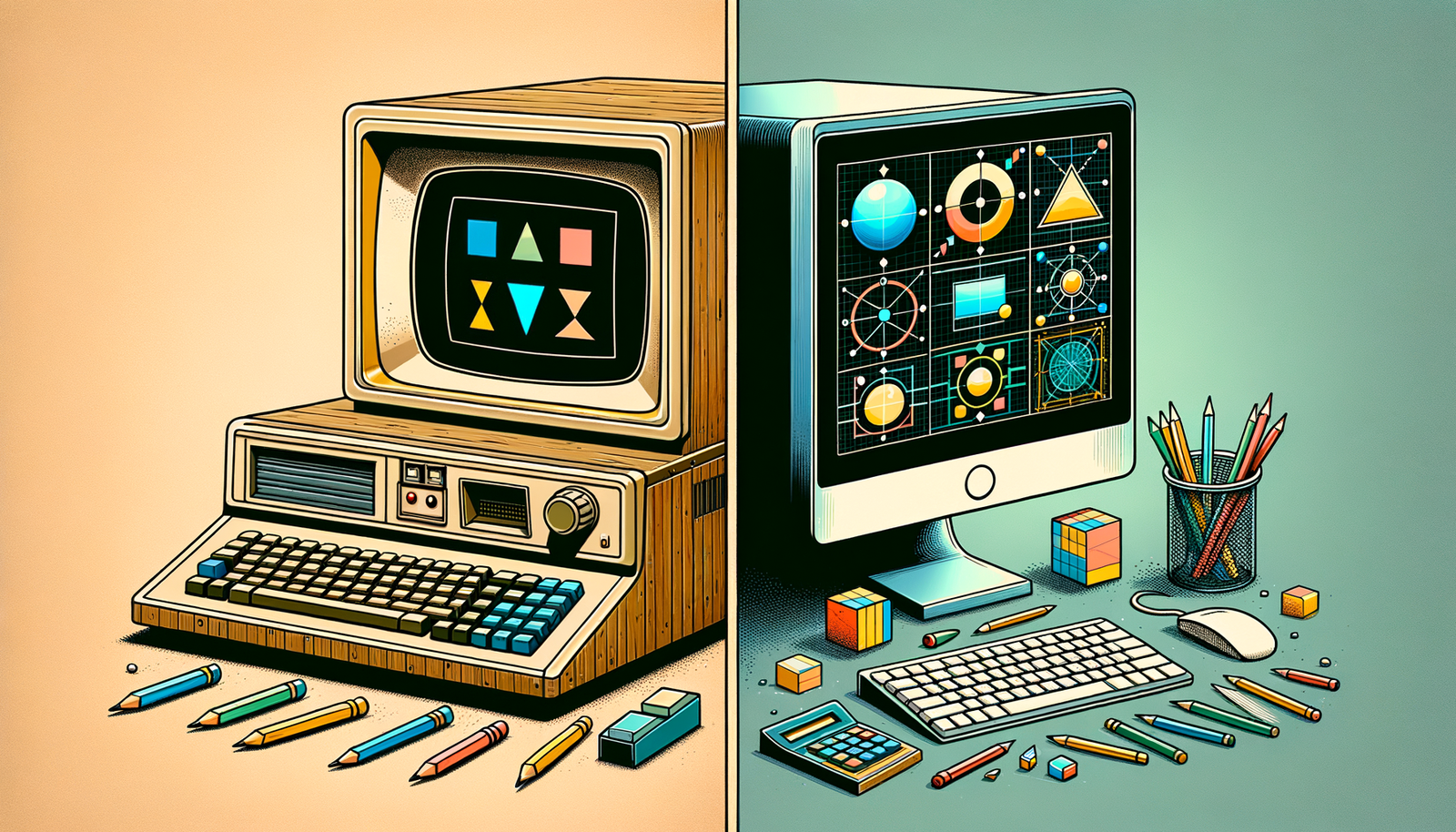Your Cart is Empty
Customer Testimonials
-
"Great customer service. The folks at Novedge were super helpful in navigating a somewhat complicated order including software upgrades and serial numbers in various stages of inactivity. They were friendly and helpful throughout the process.."
Ruben Ruckmark
"Quick & very helpful. We have been using Novedge for years and are very happy with their quick service when we need to make a purchase and excellent support resolving any issues."
Will Woodson
"Scott is the best. He reminds me about subscriptions dates, guides me in the correct direction for updates. He always responds promptly to me. He is literally the reason I continue to work with Novedge and will do so in the future."
Edward Mchugh
"Calvin Lok is “the man”. After my purchase of Sketchup 2021, he called me and provided step-by-step instructions to ease me through difficulties I was having with the setup of my new software."
Mike Borzage
Design Software History: Ivan Sutherland's Sketchpad: Pioneering the Evolution of Computer-Aided Design and Interactive Graphics
November 22, 2024 5 min read


Introduction
In the ever-evolving landscape of computer graphics and design software, few innovations have had as profound an impact as Ivan Sutherland's Sketchpad. Developed in the early 1960s, Sketchpad was a revolutionary system that laid the foundational concepts for modern computer-aided design (CAD) and interactive computer graphics. It was not merely a tool but a breakthrough that transformed how humans interact with machines, setting the stage for the sophisticated design software we rely on today. Sketchpad introduced the world to graphical user interfaces and object-oriented programming concepts long before they became standard in computing.
Ivan Sutherland, often referred to as the "Father of Computer Graphics," was a visionary whose contributions extend far beyond Sketchpad. His pioneering work at institutions like MIT and later at companies such as Evans & Sutherland Computer Corporation has been instrumental in shaping the field of computer graphics. Sutherland's innovative spirit and his ability to foresee the potential of interactive computing have inspired generations of computer scientists and designers. His contributions have not only advanced technology but have also fundamentally changed the way designers conceptualize and interact with their creations.
The Birth of Sketchpad
The early 1960s marked a period of significant technological advancement, yet the realm of computing was still in its infancy. Computers were large, room-sized machines primarily used for numerical calculations and data processing. The concept of interactive graphical interfaces was virtually nonexistent. During this era, design and drafting were manual processes, relying heavily on physical tools like pencils, rulers, and drafting tables. This manual approach was time-consuming and prone to human error, limiting the efficiency and accuracy of engineering and architectural designs. Designers lacked the ability to easily modify or manipulate designs without redrawing them entirely, a significant hindrance to creativity and productivity.
Amidst this backdrop, Ivan Sutherland developed Sketchpad as part of his doctoral thesis at the Massachusetts Institute of Technology (MIT) in 1963. Sketchpad introduced several groundbreaking features that were unheard of at the time. One of its most remarkable innovations was the interactive graphical display, allowing users to see and manipulate drawings directly on a computer screen. This was achieved through the use of a light pen, an input device that enabled direct interaction with the display by detecting light from the screen's phosphor coating. The light pen allowed users to draw geometric figures, modify them, and even establish relationships between different objects on the screen.
Moreover, Sketchpad incorporated early concepts of object-oriented programming and graphical user interfaces. It allowed users to create instances of objects and define constraints and relationships, effectively manipulating objects as reusable components. This object-oriented approach was revolutionary, introducing a level of abstraction and modularity that greatly enhanced the flexibility of design processes. Sketchpad's ability to handle hierarchical structures and constraints paved the way for more complex and dynamic design capabilities in future software.
Impact on Computer Graphics and CAD Software Development
Sketchpad's influence on the development of future graphics software and computer-aided design tools cannot be overstated. It served as the conceptual blueprint for the evolution of CAD systems, transforming the way engineers and architects approached design. The interactive and graphical capabilities of Sketchpad demonstrated that computers could be used not just for computations but also as creative tools for design and visualization. This paradigm shift led to the development of more sophisticated CAD software in the subsequent decades, such as AutoCAD by Autodesk and CATIA by Dassault Systèmes.
One of the key contributions of Sketchpad was its influence on software architectures in graphics and design applications. The notions of object-oriented programming and user-defined constraints in Sketchpad directly informed the development of programming languages and environments that support graphical applications. The ability to define objects with specific properties and behaviors became a cornerstone in software engineering, influencing languages like Smalltalk and later, C++ and Java. Additionally, Sketchpad's architecture inspired the development of graphical user interfaces (GUIs) that became standard in personal computing, leading to the intuitive interfaces used in operating systems like Microsoft Windows and macOS.
Furthermore, the principles established in Sketchpad laid the groundwork for advanced 2D and 3D modeling techniques. By introducing the concept of manipulating graphical objects on a screen, Sketchpad opened the door to three-dimensional design and visualization. This progression was essential for the development of solid modeling and parametric design software, which allow designers to create complex, variable-driven models that can be adjusted and optimized in real-time. These advancements have had a profound impact on industries such as automotive design, aerospace engineering, and architectural planning, where precise and dynamic models are crucial.
Legacy and Continued Influence
After the groundbreaking development of Sketchpad, Ivan Sutherland continued to make significant contributions to computer graphics and interactive computing. He co-founded Evans & Sutherland, a company that specialized in computer graphics hardware and software, pushing the boundaries of real-time simulation and visualization. Sutherland also worked at Xerox Palo Alto Research Center (PARC), where he influenced the development of pioneering technologies such as the graphical user interface and object-oriented programming environments. His work at these institutions fostered innovation that directly impacted the evolution of modern computing.
The philosophies and principles introduced by Sketchpad remain highly relevant in today's software tools. Modern CAD applications, such as SolidWorks and Autodesk Inventor, embody the realization of Sketchpad's concepts by providing users with powerful tools for creating and manipulating complex designs interactively. These applications utilize object-oriented principles, allowing designers to define components with specific attributes and behaviors, which can be reused and modified across different projects. The lasting impact on the evolution of user interfaces and graphical interaction is evident in the way users engage with software across various platforms, emphasizing direct manipulation, visual feedback, and intuitive controls.
Moreover, the concepts of hierarchical structuring and constraint-based design that were first explored in Sketchpad are now integral to software development and engineering processes. The ability to establish relationships and dependencies between different elements of a design allows for dynamic updating and optimization, enhancing efficiency and innovation. This approach is particularly important in fields like parametric design and generative modeling, where algorithms are used to explore a wide range of design possibilities based on predefined rules and constraints.
Conclusion
Ivan Sutherland's transformative role in the history of design software through his creation of Sketchpad cannot be understated. His vision and innovation set in motion a series of developments that have profoundly influenced computer graphics, user interface design, and software development. Sketchpad was not just a technological achievement but a conceptual leap that redefined human-computer interaction, setting new standards for interactivity and graphical manipulation in computing.
By laying the foundational principles for interactive design and object-oriented programming, Sketchpad set the stage for the exponential growth and sophistication of design technologies over the decades. The evolution from simple graphical displays to complex 3D modeling and simulation software can be traced back to the concepts introduced by Sutherland. His work has enabled designers and engineers to push the boundaries of creativity and innovation, leading to advancements in numerous industries and improving the quality and efficiency of design processes.
As we continue to explore new frontiers in design software, it is essential for future innovators to draw inspiration from Sutherland’s pioneering spirit. His ability to envision and realize technologies ahead of his time serves as a testament to the value of creativity, curiosity, and perseverance in technological advancement. By embracing these qualities, the next generation of designers and developers can continue to drive innovation, shaping the future of design software and its applications across various fields.
Also in Design News

Cinema 4D Tip: Creating Futuristic Visuals in Cinema 4D with Advanced Techniques and Tools
October 27, 2025 3 min read
Read More
Bluebeam Tip: Optimizing Precision with Bluebeam Revu's PDF Measure Tool
October 27, 2025 2 min read
Read More
AutoCAD Tip: Enhancing Efficiency and Precision with AutoCAD's ROTATE Command: Best Practices
October 27, 2025 2 min read
Read MoreSubscribe
Sign up to get the latest on sales, new releases and more …


